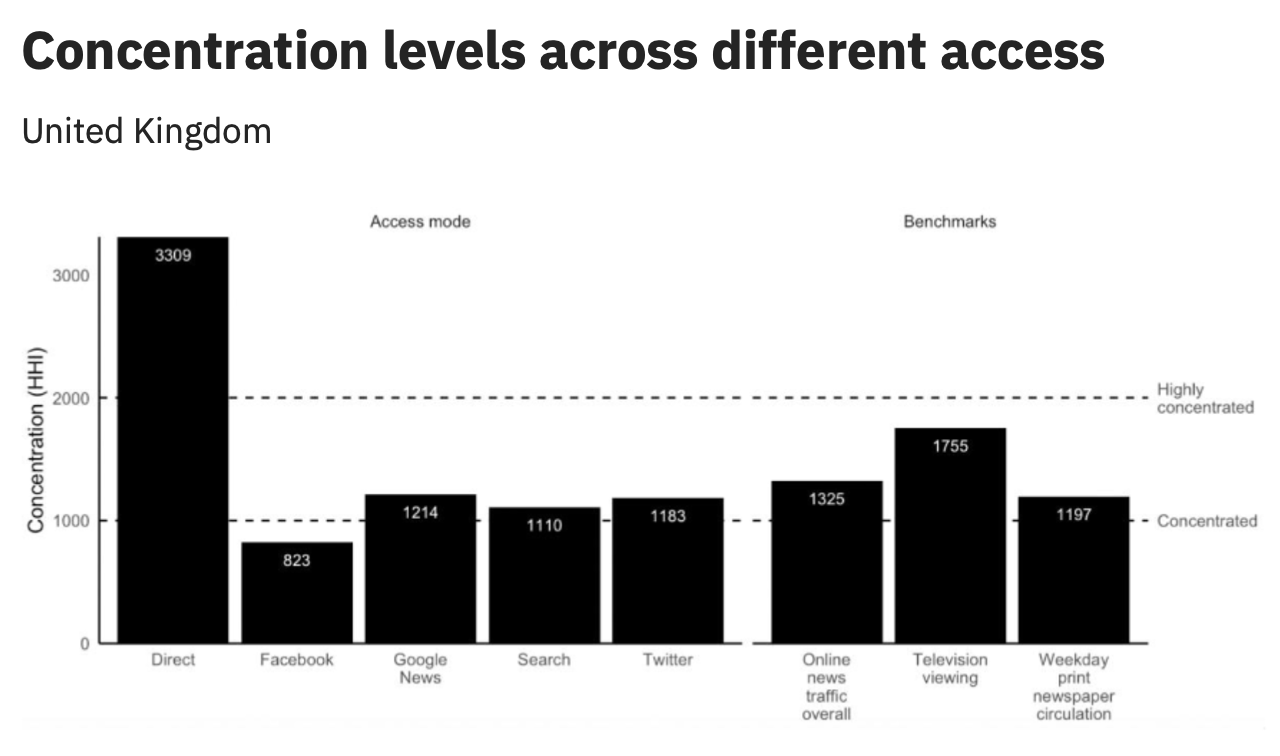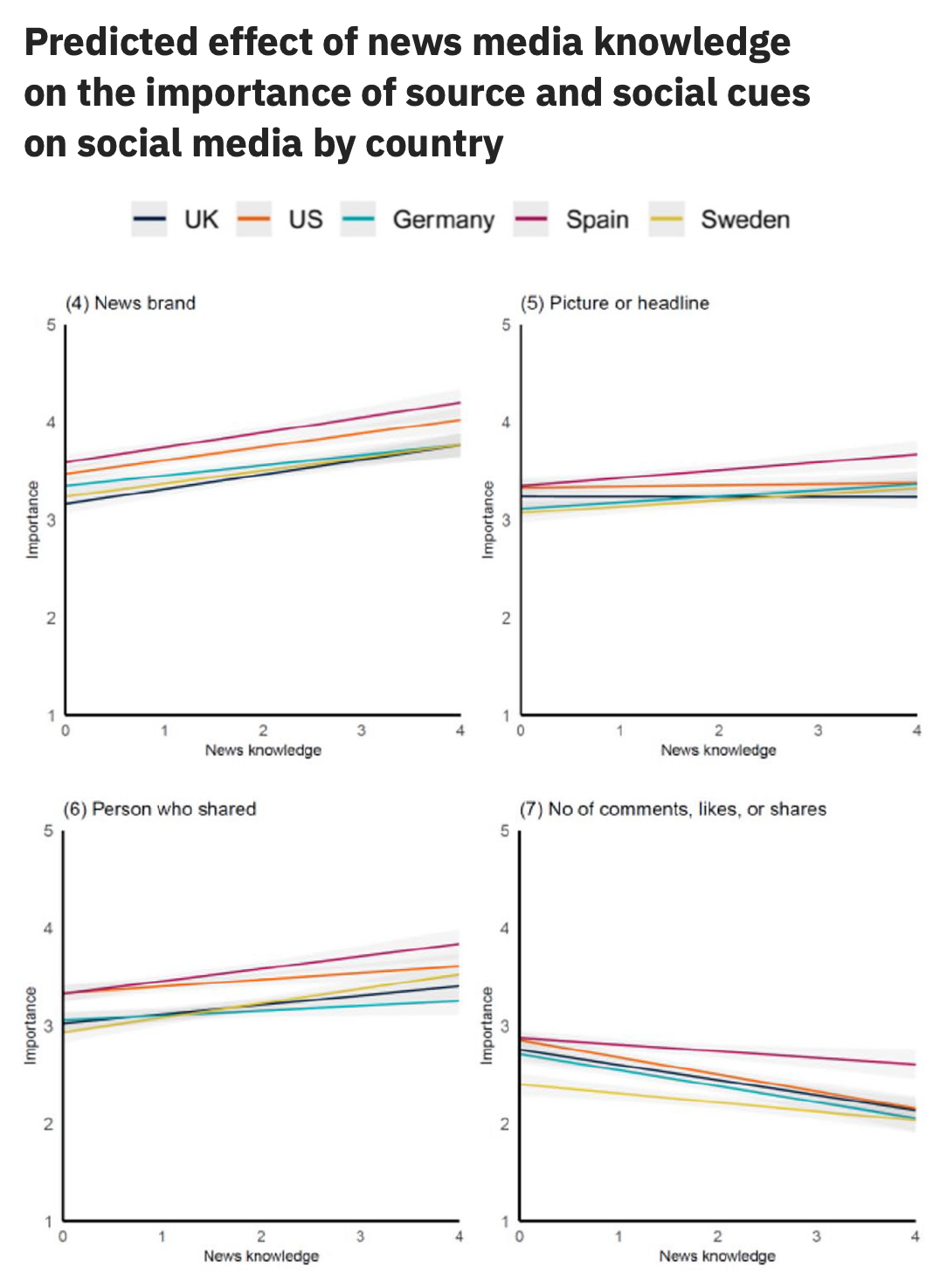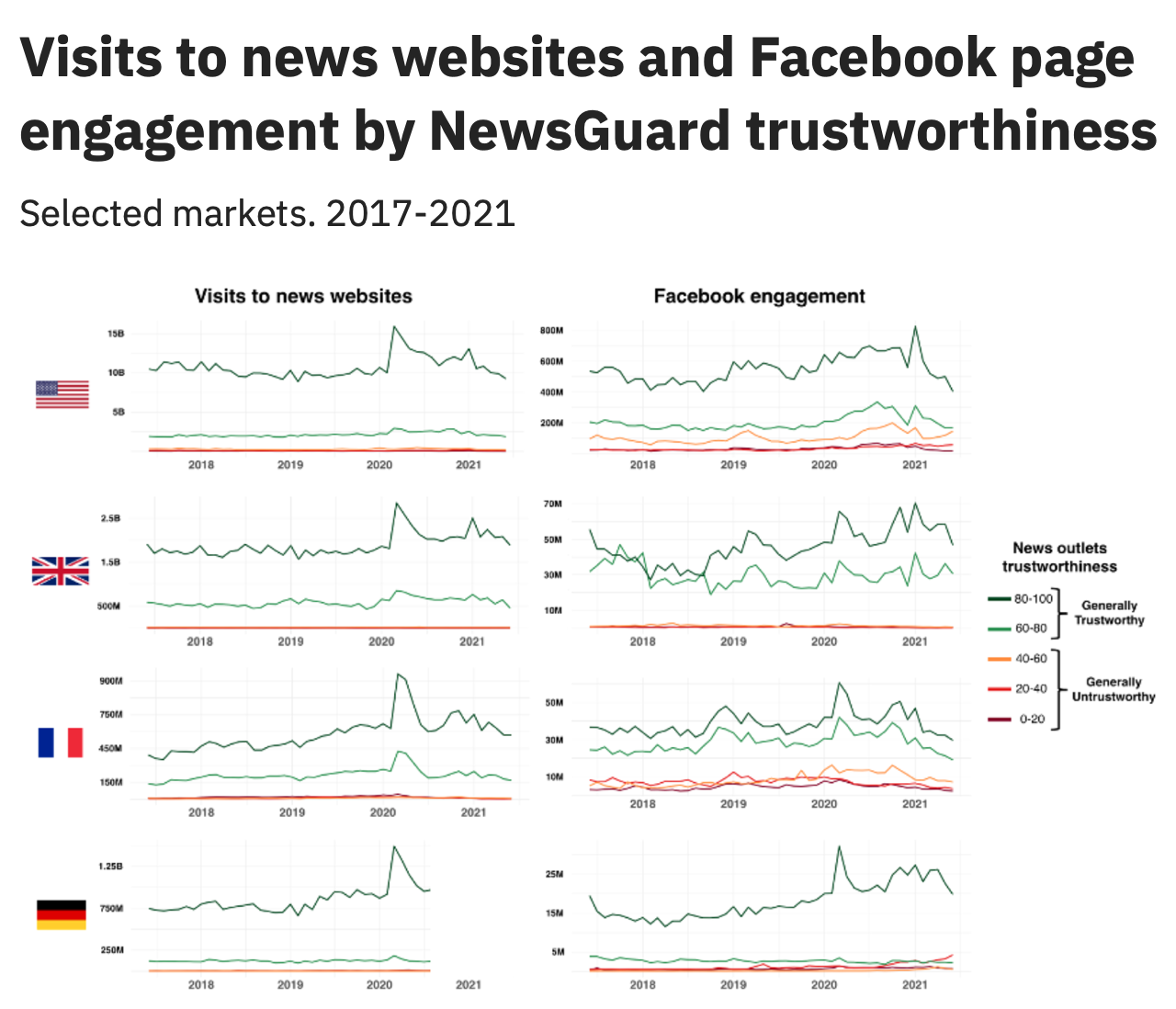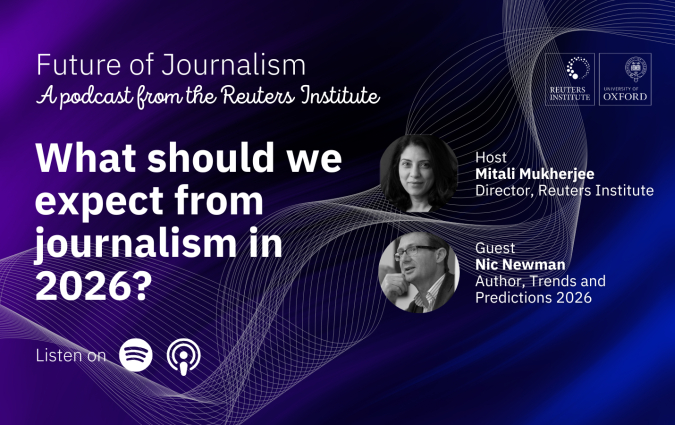22 findings from the Reuters Institute’s research in 2022 still relevant in 2023

A man and a toddler cross the Irpin river under a destroyed bridge in early March 2022. REUTERS/Gleb Garanich
2022 has been a challenging year for journalism. While reporting on Putin’s brutal invasion of Ukraine and on the last stages of a global pandemic, news organisations struggled with loss of interest, news avoidance and distrust. TikTok news use exploded and podcast listening grew after the hiatus of COVID-19. News organisations struggled to engage with younger audiences and found it difficult to monetise their output in social networks and messaging apps.
Even more newsrooms embraced reader revenue but not everyone succeeded in making people pay for news. Companies grappled with building diverse and inclusive newsrooms and keeping valuable talent, and they tried to embrace hybrid work in a way that worked for every member of their staff. As the year draws to a close, here are 22 findings from our research in 2022 that will be still relevant in 2023.
1. News avoidance is growing sharply in many countries
The Digital News Report 2022 found that the proportion who say they actively avoid news sometimes or often has increased sharply in many countries. This type of selective avoidance has doubled in both Brazil (54%) and the UK (46%) over the last five years, with many respondents saying news has a negative effect on their mood. | Learn more
2. Some young people avoid the news because they find it hard to understand
Our report also found that some younger and less educated people say they avoid news because it can be hard to understand. In countries such as Australia, the United States and Brazil, around 15% of younger news avoiders say they find news hard to follow – a much higher proportion than among older people. This could relate to the complexity of the language or assumed knowledge but also to the way young people follow the news on social media, where they might miss key context that was packaged into linear narratives. | Learn more
3. Young audiences often get their news from social media
Social networks have steadily replaced going direct to news websites or apps as the main way to access news online for younger audiences in recent years. As the next chart shows, those within the 25–34 group and those older than 35 in the UK have only slightly changed their main access to news. The 18–24 group, though, has become significantly less likely to start their news journey with a news website or a news app. | Learn more
4. News use via search, social and aggregators is less concentrated than direct access
What is the effect of search engines, social media and aggregators on news media plurality? Based on web tracking data from the UK, our peer-reviewed study found that most direct traffic goes to a small number of popular outlets, and is thus highly concentrated (according to HHI, a widely-used measure of market concentration). However, news traffic via platforms is much more evenly split across different outlets, creating lower levels of concentration. In November, Ofcom replicated our study using more up-to-date tracking data and reached a similar conclusion. | Learn more

5. Trust in news on platforms is lower than trust in news overall
According to survey data from Brazil, India, the UK and the US, levels of trust in news on social media, search engines and messaging apps is consistently lower than audience trust in news more generally. A considerable portion of this trust gap is explained by lower levels of trust among people who do not use platforms. Most of the people who lack trust in news on digital platforms tend to be older, less educated and less politically interested, and many express less trust in news regardless of whether found on platforms or through traditional channels. | Learn more
6. People who know more about the news media use social media differently
Some people know more about how the news media works than others, but is this linked to different patterns of news use? In a peer-reviewed study in five countries, we found that people with higher news media knowledge are more likely to use social media as a source of news, but typically as a supplement, rather than as their main way of staying informed. We also found that, when using social media for news, people who know more about the news media say they pay more attention to the brand and to editorial cues, but less attention to the number of likes, comments and shares a story has. | Learn more

7. Many see misinformation and harassment as big problems for platforms
Misinformation and harassment are among the leading problems many people in Brazil, India, the UK and the US associate with digital platforms. Many people in all four countries agree that false and misleading information, harassment, and platforms using data irresponsibly are ‘big problems’ in their country for many platforms. In the US and the UK, larger percentages singled out Facebook in particular when it came to these problems, whereas elsewhere people saw such problems as applicable to all four platforms we asked about. | Learn more
8. Trustworthy news outlets saw bigger increases in traffic during the COVID-19 pandemic
By combining data from Comscore and NewsGuard in France, Germany, the UK and the US, we found that more trustworthy news outlets benefited the most from the increase in web traffic resulting from the pandemic in 2020. However, outside of the UK, both trustworthy and untrustworthy news outlets saw similar increases in Facebook engagement. Overall, our peer-reviewed study found that people largely turned to trustworthy news outlets during the 2020 coronavirus pandemic—but untrustworthy news outlets captured 2.3% of web traffic and 14% of Facebook engagement, while news outlets regularly publishing false content accounted for 1.4% of web traffic and 6.8% of Facebook engagement. | Learn more

9. Audiences use shortcuts when assessing the credibility of news on digital platforms
Our qualitative research showed that when audiences assess the credibility of the news they encounter on digital platforms, they often rely on cues for making snap judgements, which are particularly important since many of these users rarely clicked through to the original sources of news.
The mental shortcuts people discussed involved pre-existing ideas they held about news in general or specific news brands (where the information was coming from), social cues from family and friends (who shared or engaged with the news), the tone and wording of headlines (whether or not it was perceived as clickbait), the use of visuals (which they often saw as important evidence for what could or could not be trusted), the presence of advertising (whether or not information appeared to be sponsored) and additional platform-specific cues also played a role in shaping judgements about what to trust. | Learn more
10. Publishers are pragmatic in their approach to platforms
Our interviews with a strategic sample of 11 publishers in eight low- and middle-income countries showed that the approaches they take to platforms can be summarised as platform pragmatism and are based on five broadly shared components:
- clarity about editorial mission, funding model, and target audience
- adaptability to a constantly changing environment and transient platforms
- selective and diverse investments in platforms to pursue key platform opportunities while hedging against platform risk
- proactive relations to identify useful contacts inside platform companies
- constant monitoring of the editorial and financial return on investment in platforms. | Learn more
11. Facebook remains the most-used social network for news
Facebook is still the most-used social network for news, closely followed by YouTube in Asian markets. However, more visual networks such as Instagram and TikTok have grown very fast, especially among young audiences. According to our Digital News Report 2022, use of these platforms is much higher in parts of Latin America and Africa than it is in North America or Europe. | Learn more
12. Young audiences are increasingly using TikTok for news
Our figures show rapidly growing usage of TikTok for news, especially in Africa, Asia, and Latin America as well as across Eastern Europe. Usage is mostly still with people under 25, but is extending into all age brackets in countries with higher levels of usage, such as Kenya, South Africa, Thailand, Indonesia, Brazil and Peru. | Learn more
13. Podcast listening is growing again after COVID-19 hiatus
Podcast growth has resumed this year in more than half of our markets after COVID-19 had disrupted the commute to work, negatively affecting some forms of audio use. Looking at an average of 20 countries where we are confident that the term ‘podcast’ is well understood, we find 34% (+3) consumed one or more podcasts in the last month, with 12% accessing a news podcast. Ireland, a country with a strong audio tradition, heads our list, along with Sweden, the home of Spotify. | Learn more
14. Most people prefer to read rather than watch their news
Markets with historic patterns of high newspaper consumption such as Finland top the next chart, which tracks reading preference among the countries covered by the Digital News Report 2022, with low-newspaper-circulation countries like Thailand and Brazil near the bottom. Other factors are also likely to be at play. Higher use of social media in Latin America (Mexico, Peru, Colombia, and Chile) as well as in parts of Asia-Pacific (Philippines and Taiwan) may be encouraging more video news use in these markets. | Learn more
15. Newsrooms leaders are still betting on reader revenue
According to our survey of 246 newsroom leaders at the end of 2021, subscription remained the number one priority (79%) for commercial publishers ahead of display advertising (73%) and native advertising (59%), events (40%) and funding from platforms (29%), which grew significantly in 2021. Almost half of news leaders, however, worried that subscription models may be pushing journalism towards super-serving richer and more educated audiences and leaving others behind. | Learn more
16. Most newsrooms leaders are embracing hybrid work
Up to 61% of the 136 newsroom leaders surveyed for our Changing Newsrooms report say their news organisations have largely implemented hybrid and flexible working. Only 20% largely want to go back to a pre-pandemic model. Almost half of newsroom leaders think flexible working has made it easier to acquire and retain talent (49%) and build more diverse teams (45%). | Learn more
17. Most newsroom leaders think their organisations are doing well in terms of gender diversity
The majority of the newsroom leaders we surveyed think their organisations are doing a good job with gender diversity (79%), but less so when it comes to ethnic diversity (47%), diversity from less-advantaged backgrounds (30%), and political diversity (27%). One-third of the leaders who participated in the survey indicated gender diversity as the single most important priority for their news organisation to change, while another 32% indicated ethnic diversity, followed by more representation of those from a less-advantaged background (13%) and more political diversity (9%). | Learn more
18. Only 21% of the 179 top editors across 240 major outlets in 12 markets are women
In 11 out of 12 markets covered in a factsheet we published in March, the majority of top editors are men, including in countries like Brazil and Finland where women outnumber men among working journalists. The percentage of women in top editorial positions varies significantly from market to market, from 7% in Brazil to 50% in the US. No market in our sample has a majority of women top editors this year. | Learn more
19. Almost four out of five of the top editors across 100 brands in five markets are white
In Brazil, Germany and the UK, as in 2021, all of the outlets in our sample have white top editors. In every single country covered by the factsheet we published in March, the percentage of white people in the general population is much lower than it is among top editors. There has been no significant overall decrease in the number of white top editors over the last year across the markets covered in the factsheet we published in March. | Learn more
20. Many news executives think it’s tough to cover climate change well
Although only one third of the news executives surveyed for our Trends and Predictions report (34%) rated climate coverage in general as good, two-thirds (65%) felt their own coverage was good. News editors said it is hard to get mainstream audiences to take notice of a story that moves slowly and can often make audiences feel depressed. In turn this means it’s hard to make the case to hire the necessary specialist journalists to explain and bring it to life. | Learn more
21. Many people don’t follow news about climate change every week
On average around half of respondents to our report on climate change news say they have engaged with climate change news or information in the past week. There is some variation across countries, with the percentage ranging from a low of 38% in India to a high of 66% in France. About one in seven have seen some climate news in the past two weeks. A large minority of less engaged users say they have come across climate change news or information less frequently than that, but only a tiny proportion say they never see any news or information about climate change. | Learn more
22. Climate news users feel they understand what climate change is, but are less confident about their knowledge of climate policy
Our report on climate change news use also found that across the eight countries, a large majority of our respondents across these countries recognise the scientific consensus on human induced climate change, and are worried about the impact. Those who consume climate change news more frequently are more likely to feel they know a lot or a moderate amount about what climate change is, but do not feel any more informed about government policy or global initiatives to tackle climate change than those that hardly ever access climate news. This highlights where the news media could do more to inform their audience. | Learn more
In every email we send you'll find original reporting, evidence-based insights, online seminars and readings curated from 100s of sources - all in 5 minutes.
- Twice a week
- More than 20,000 people receive it
- Unsubscribe any time






